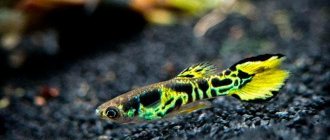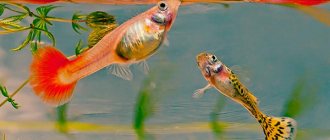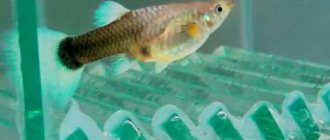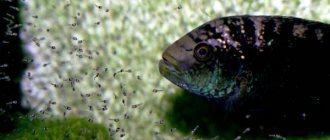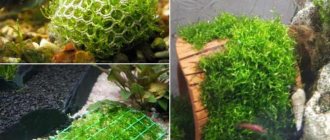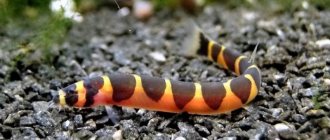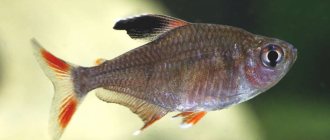Red guppies
This group can include all guppies that are red in color, but have a variable pattern - this is a solid red color, red blond guppy, red dragon guppy, red mosaic, red platinum, red-black, red Tuxedo, red Moscow, flamingo guppy, scarlet, red snakeskin, etc.
Red snake skin guppy
Red cobra guppy photo
Red dragon guppy photo
Super red guppy photo
Guppy red blond photo
Guppy flamingo photo
Mistakes of new guppy lovers
The main mistake that beginning guppy lovers make is keeping several breeds at once (“compote”) in one aquarium, which results in a low-value cross between the offspring.
Another group of common mistakes made by beginning guppy lovers is keeping fish in too cramped living conditions, using containers with an insufficient volume of water for normal life activities, excessively high stocking density of fish, sudden changes in biological and chemical indicators of water and conditions for keeping guppies.
It is important that in some cases, color genes are associated with the size and shape of both the fish themselves and their fins. That is, in other words, if you cross blue long-finned guppies with guppies that have the same long fins, but a different color, for example, red, it is not necessary that the offspring will have fish with the same fins. There is a high probability that the result will not be very good.
Guppies are black
This group includes black guppies under loud names such as: black monk, black prince, black tuxedo, black Moscow. The problem with this group is the difficulty of selectively retaining black tones. Therefore, good black specimens of guppies are highly valued by aquarists.
Guppy black monk photo
Black Moscow Guppy photo
Guppy black prince photo
Black Tuxedo Guppy photo
Guppy solid black photo
Guppy breeding
Guppy is a viviparous aquarium fish, one of the most popular among aquarists. It is unpretentious in maintenance and has sexual differences: females and males differ from each other in size, color and even shape. In an aquarium, guppies become slightly larger than in nature.
The size of males ranges from one and a half centimeters to four, and purebred guppies have long fins with bright colors. The male guppy's genital organ is a fin located at the anus and has a phallic shape.
Females are larger than males, and their length ranges from two and a half centimeters to seven. The abdomen of females is enlarged, and eggs can be seen in the anal area. The fins of females are smaller than those of males.
There are several breeds of guppies.
Guppy fish become sexually mature at the age of four to five months.
It is not difficult to breed guppies, but before you do this, you need to carefully study the literature on breeding, as it has its own characteristics and nuances.
Guppy breeding how to distinguish a pregnant female
The gestation period of guppies depends on the temperature of the water and can last from 21 to 40 days.
The duration of gestation depends on the number of fry in the womb. The female guppy does not lay eggs, but gives birth to fry, which are already ready to exist in the aquarium.
It is not recommended to change anything in the contents at this time: a female preparing for childbirth becomes very sensitive to any changes in temperature in the aquarium. The calmer the female is, the more successful the birth will be.
It is enough for a female to mate with a male once, and she will be able to give birth several times every month or month and a half. Several cases have been recorded where the female gave birth even a year after mating. Therefore, if aquarists are interested in breeding a new breed of guppies, they should use “virgins” - these are females raised separately from males.
Guppy fertilization is internal; the male injects sperm using the gonopodium (modified anal fin).
Also interesting: Soil for an aquarium
A distinctive sign of a pregnant female is the appearance of an enlarged, ball-like belly. Then the “ball” turns into a “rectangle”, with a dark spot in the lower abdomen. The anus appears swollen and red.
This “rectangle” indicates that the guppy is about to give birth. To see this “rectangle”, you need to “look straight into the eyes” of the fish, finding a position strictly opposite to your face. From this perspective, you can see that the female’s head is much smaller than her body, and her stomach has a square or rectangular shape.
Males behave inappropriately during the period of pregnancy of females: they constantly chase females, huddling in groups. They seem to be trying to bury themselves down the fish's belly. This behavior of males is often called “courtship,” however, the future “mother” tries to hide from her pursuers somewhere in the thickets.
Reproduction of guppies, when to place the female for childbirth
Just before giving birth (a few days before), when the tummy takes on a rectangular-square shape, the female needs to be placed in another aquarium (aquarium). Its volume can be from 15 to 30 liters. If the size is smaller, then the quality of the water in the aquarium may drop, and if it is smaller, then it will be more difficult to feed the fry and observe their growth and behavior. It is better to pour water into the fish tank from the aquarium in which the pregnant female lived before giving birth.
It should be taken into account that relocating a female to another environment that is unusual for her can cause stress in a pregnant guppy. She may lose her appetite and thereby undermine her health. This stressful condition can be fatal. To prevent this from happening, the female should be taken to give birth when there are two or three days left before giving birth.
Nowadays, pet stores sell special “maternity” trays. They can be attached directly to the aquarium. The fish will thus be in “its home,” and stressful situations (which sometimes delay childbirth) can bypass the future “mother.” To stimulate labor, you can increase the temperature of freshly settled water in the fish tank by 2 - 3 degrees.
Also interesting: The aquarium is leaking
The main thing here is not to overdo it with fresh water, otherwise labor may occur prematurely, and then the premature fry will be born weak and susceptible to any diseases.
Just before giving birth, females begin to tremble, become inactive, and refuse to “eat.” In some cases, vomiting was observed.
The process of producing offspring in guppies usually begins either in the evening or early in the morning and lasts several hours. During childbirth, the female's tail begins to tremble, sometimes she freezes for a short time.
The fry that are born are quite active, but some of them are inactive and lie on the bottom of the aquarium. There is no need to worry; later they will gain strength and catch up with their peers.
If childbirth is delayed, a young and energetic male is placed in the aquarium with the pregnant female.
After the female gives birth, they need to be separated. The female is separated from the fry after 24 hours. The fact is that the female guppy lacks maternal instinct.
Very often after childbirth, and even during it, the female begins to eat her offspring. The fry will be born quite independent and do not need parental care. They try to stay in the upper layers of water, begging for food. In the first days, babies are fed at least five times a day.
Ciliates are considered the best food. Then, after about two months, the number of meals is reduced to two times, and “adult” food is used (chopped bloodworms, for example). Some “nutritionists” recommend including boiled egg yolk diluted with water from the aquarium in the fry’s diet. This will be an additional dietary supplement.
Guppies reproduce actively and very quickly; the female gives birth to offspring every 3 weeks at least. The absence of fry in the aquarium indicates that the juveniles are eaten by adults. If you become familiar with the proper conditions for keeping these tiny fish and caring for the fry, then delightful guppies will delight you, give you pleasure and relieve the stress that you have accumulated.
Category: Aquarium fish
Guppy green
Green cobra, green Moscow guppy, snake skin +++
Green Moscow guppy photo
Green snake skin guppy photo
Guppy green cobra photo
Guppy yellow
This group includes all guppies with predominant yellow tones: yellow tuxedo, yellow cobra...
Yellow and then white, albino breeds, all these are xanthorist - aquarium discoloration mutations. Their breeders fix them genetically. Xanthorists are fish that are discolored by developing a yellow tint instead of red or green. Yellow guppies are xanthorista. White, albinos are super xanthorist freaks. All these are scientific terms without any hype. A freak is an individual with congenital body defects, possibly due to a genetic defect or exposure to negative factors in the embryonic period. And period.
And you say that GLO-fish is wow wow. Here, before Glo, how much wood humanity has chopped up, so mother, don’t worry.
Guppies yellow Berlin photos
Guppy yellow cobra photo
Yellow Tuxedo Guppy photo
Guppy selection techniques
For the selection of guppies, improving three-line breed maintenance is most often used. This means that three containers with a volume of about 20 liters contain 3 pairs of manufacturers. For their offspring, 6 feeding aquariums with a volume of about 100 liters are used, in which males and females are kept separately. Also, for raising fry and juvenile guppies, additional containers are used, the number of which varies in each case. After the breeders complete their reproductive lives, they are replaced by their own best offspring. In this case, a female from the first parental pair is placed with a male born from the third pair of producers, a female from the second pair of producers is placed with a male from the first pair of producers, a female from the third pair of producers is placed with a male from the second pair of producers. Such a shift is made with each change of generations of fish to reduce the effect of inbreeding, as a result of which the health of subsequent generations, size and coloring deteriorate, but nothing more. This problem is solved in the best way - by exchanging unrelated fish of a similar breed with other guppy breeders from other cities and even countries; in the worst case, mixing with another breed is used.
White guppies
Albino guppy photo
White Moscow guppy photo
White platinum guppy photo
Guppy cobra
And finally, let’s highlight two more popular morphs of the common guppy, the qualification for which is the body pattern. Cobra guppies are all guppies with “snake skin”.
Guppy cobra blue photo
Guppy cobra green photo
Yellow cobra guppy photo
Red cobra guppy photo
Guppy Cobra Ceylon photo
Guppy breeding
The female's pregnancy, depending on the temperature of the water in which the fish is kept, lasts 21-40 days. At the end of the gestation period, depending on the age and size of the female, the female gives birth to 10 to 200 fry. A single mating is enough for several fertilizations: the female gives birth to fry in portions every month to a month and a half. Cases have been repeatedly recorded in which females continued to give birth to fry 12-14 months after mating. Therefore, virgin females are used in breeding, raised in isolation from males.
For the first week, the juveniles are kept in the hatchery where they were born, and then transferred to larger containers. At one month of age, the fry begins to “determine itself,” that is, the difference between males and females becomes noticeable. In females, the so-called birthmark becomes visible - a darkening in the anal area (in breeds with a light background color, the birthmark is difficult to distinguish). At 2-3 months, the anal fin of males begins to change, turning into a gonopodium. Depending on the race of the guppies, the conditions of detention and the experience of the aquarist, the sex of the fry can be determined starting from 14-30 days of age.
To avoid uncontrolled reproduction of guppies, it is necessary to separate the juveniles by sex and keep them separately. In winter, you can maintain the temperature of the water with guppies within +18.0 °C, which will not only avoid unnecessary spawning, but also give females a break from giving birth.
